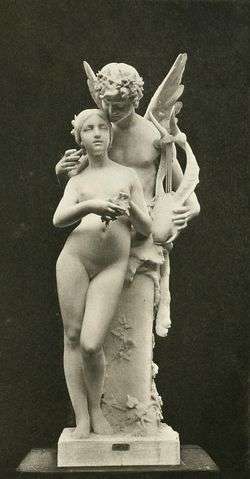Alphonse-Amédée Cordonnier

Printemps
Alphonse-Amédée Cordonnier (1848–1930) was a French sculptor.
Born in La Madeleine, Nord, Cordonnier was educated in nearby Lille, then in Paris, then in Rome, on a scholarship funded by the foundation of Jean-Baptiste Wicar. Cordonnier won the Prix de Rome for sculpture in 1877.
Combined with his realistic style, many of Coronnier's themes are progressive and socially minded, for example his Les Miséreux (the Destitute), Les Pauvres gens (the Poor), and L'inoculation et la fermentation (Inoculation and Fermentation), all to be seen at the Palais des Beaux-Arts de Lille.
Work
- Printemps (Spring), 1883
- Maternity, now in the Place Adolphe-Chérioux, 15th arrondissement of Paris, 1899
- allegorical facade figures of Education and Vigilance for the Hôtel de ville in Tours, circa 1900, for architect Victor Laloux
- allegorical figure of Sculpture (1900), facade of the Grand Palais, Paris
- The Sower, now at La Piscine Museum, Roubaix, 1907
- figures representing cotton-gathering and sheep-shearing, Hotel de Ville, Roubaix, 1911, for architect Victor Laloux
- the figure of Music, holding a lyre, for the facade of the Opéra de Lille, completed 1914, inaugurated 1923, for architect Louis M. Cordonnier
- Monument to Louis Pasteur, in Lille
- Jeanne d'arc, Palais des Beaux-Arts de Lille
| Wikimedia Commons has media related to Alphonse-Amédée Cordonnier. |
This article is issued from Wikipedia - version of the 10/10/2016. The text is available under the Creative Commons Attribution/Share Alike but additional terms may apply for the media files.